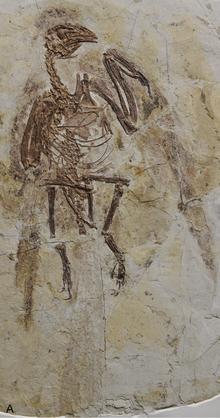Pengornithidae
| Pengornithids Temporal range: Early Cretaceous,
| |
|---|---|

| |
| Fossil specimen of Parapengornis eurycaudatus | |
| Scientific classification | |
| Domain: | Eukaryota |
| Kingdom: | Animalia |
| Phylum: | Chordata |
| Clade: | Dinosauria |
| Clade: | Saurischia |
| Clade: | Theropoda |
| Clade: | Avialae |
| Clade: | †Enantiornithes |
| Family: | †Pengornithidae Wang et al., 2014 |
| Type genus | |
| †Pengornis Zhou, Clarke, & Zhang, 2008
| |
| Genera | |
Pengornithidae is a group of early enantiornithines from the early Cretaceous Period of China. Specimens of these animals have been found both in the Huajiying Formation and Jiufotang Formation of Liaoning and Hebei provinces, dating from the Hauterivian age (130.7 million years ago) to the Aptian age (120 million years ago).[1]
Description
Pengornithids were primitive enantiornithes. They had many small teeth in their jaws, and stout legs. Their internal anatomy was characterized by a hooked outgrowth of the shoulder blade and a pygostyle (the tail bone to which long feathers attach) which was short and rounded, instead of long and blade-shaped as in other enantiornithes. While most enantiornithes had four long backward projections growing from their breastbones, pengornithids only had two.[2]
Ecology
The unique, rounded pygostyle and long, stiff tail feathers of pengornithids would have made their tail overall similar to that of woodpeckers. The feet of pengornithids were also particularly adapted for grasping branches. These features indicate that while pengornithids may not have been as adept at climbing as many modern birds, they were better climbers than many other enantiornithes.[2]
Classification
The cladogram below was found in the phylogenetic analysis of Hu et al. 2014.[2]
The cladogram below was found by an analysis by Wang et al. in 2015, updated from a previous data set created by Jingmai O'Connor.[3]
| Ornithothoraces |
| ||||||||||||||||||
References
- ^ Wang, X.; O'Connor, J. K.; Zheng, X.; Wang, M.; Hu, H.; Zhou, Z. (2014). "Insights into the evolution of rachis dominated tail feathers from a new basal enantiornithine (Aves: Ornithothoraces)". Biological Journal of the Linnean Society. 113 (3): 805–819. doi:10.1111/bij.12313.
- ^ a b c Hu, Han; o'Connor, Jingmai K.; Zhou, Zhonghe (2015). "A New Species of Pengornithidae (Aves: Enantiornithes) from the Lower Cretaceous of China Suggests a Specialized Scansorial Habitat Previously Unknown in Early Birds". PLOS ONE. 10 (6): e0126791. doi:10.1371/journal.pone.0126791. PMC 4454694. PMID 26039693.
{{cite journal}}: CS1 maint: unflagged free DOI (link) - ^ Wang, Hu; Li (2015). "A new small enantiornithine bird from the Jehol Biota, with implications for early evolution of avian skull morphology". Journal of Systematic Palaeontology. 14 (6): 1–17. doi:10.1080/14772019.2015.1073801.


